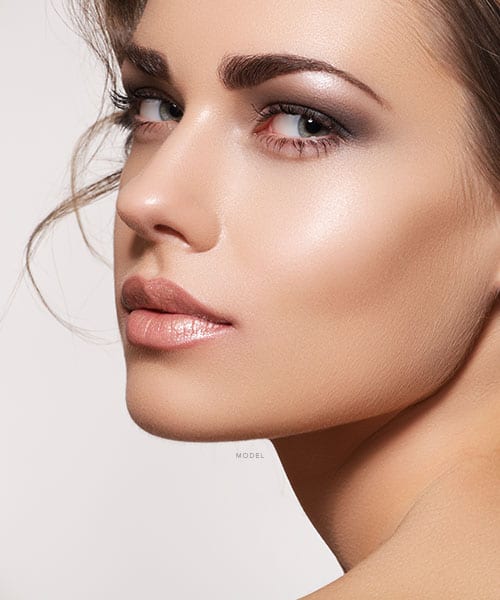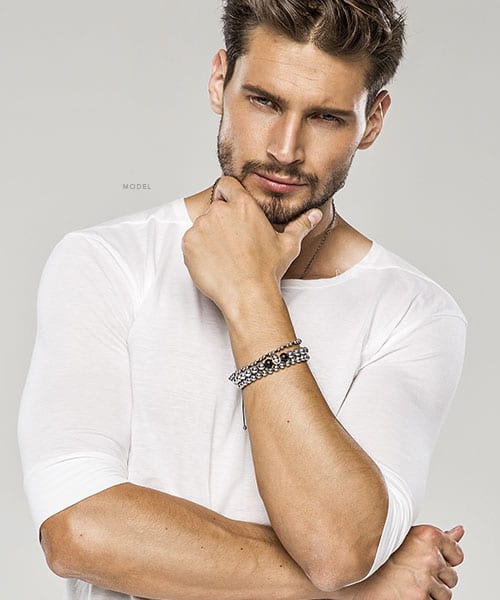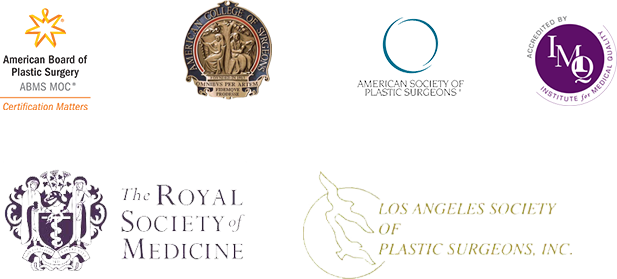Rhinoplasty in Beverly Hills, CA
The nose is one of the most prominent and noticeable of all of facial features. Its appearance in relation to other facial features has an immense effect on your overall appearance. In addition, the nose performs critical factions allowing passage of air for breathing and controlling the conditioning and flow of the air before it reaches the lungs.
Visually apparent external nasal deformities are frequently but not always associated with internal nasal deformities which affect airway obstruction. Nasal deformities can result from previous traumatic injury to the nose, or may result from hereditary or other causes.
Structurally, the nose can be envisioned as a tripod of viewed with the head tilted back. The side walls of the nose form the outsides of the tripod, with the septum (which divides the nose in half internally) being the central support of the tripod. When the nose is broken or damaged by trauma, very frequently there is a disruption of both the outer walls of the tripod (nasal bones) as well as the central internal strut (nasal septum). When the nasal septum is bent, broken, or otherwise deviated or damaged, it can produce obstruction of the nasal airways which pass between the limbs of the tripod. To achieve adequate straightening of the septum surgically, it is frequently necessary to reposition external and internal structures.

Operative procedures done by Dr. Calabria in Beverly Hills, Palm Springs and Italy, to modify or correct septal abnormalities are called Septoplasty or Submucous Resection. Their purpose is to correct deformities of the nasal septum to improve or alleviate airway obstruction.
Another major category of nasal surgical procedures is directed toward improving the external appearance of the nose, and these are termed Rhinoplasty. The purpose of these procedures is to improve specific nasal characteristics which detract from nasal and facial appearance in order to obtain a more harmonious aesthetic balance of the nose with other facial features.
Rhinoplasty, Septoplasty, and Submucous resection are operations which are accomplished through small incision inside the nose. Rhinoplasty may be performed separately or in conjunction with Septoplasty or Submucous resection depending on the nature and extent of the deformities involved.
The nose is an extremely complicated facial feature structurally, and is unique in each individual. Its aesthetic contribution to the overall appearance to the face is immense, both in desirable and undesirable characteristics. Due to the unique structure and appearance of your nose, in rhinoplasty perhaps more than any other aesthetic operation, the individuality of your nasal structures and their relationship to other facial features must be recognized and respected. In formulating your operative plan, I will always try to preserve those “positive” characteristics which make your nose individual and unique and modify or improve only those characteristics which detract. It is illogical to envision “the perfect nose” and try to create this image on your face. This approach ignores the essential balance between your nasal and facial characteristics and predictably results in a result which does not “fit” your face. Modifications of specific, limited, undesirable characteristics to achieve a more harmonious balance of nasal and facial features are my goal in rhinoplasty.
Disregard of these principles also predictably results in a nose which is “over-operated” and looks “over-operated.” Perhaps in no other aesthetic procedure is the principle of conservatism as important as in rhinoplasty. For this reason, considerable time will be spent in discussing with you those nasal features which you consider undesirable and the limits of safe operative approach to correcting them without producing the “operated” lock so frequently seen following rhinoplasty.
In approaching operative correction of nasal deformities, judgments will be made on the conservative side in all cases. Minor adjustments or additional revisions following initial rhinoplasty may be necessary in 2% of my patients, but these are minimal compared to the major problem of dealing with an initial procedure that was too radical in its approach. The structural elements of the nose are unique in their characteristics and arrangement, and extremely difficult t to reconstruct when excessively removed. Since the nose changes for several months following surgery, any necessary revisions are usually delayed for 6-12 months. I do not charge a surgery fee for necessary revisions. You will be responsible for surgery facility and anesthesia fees if they are not covered by your insurance.
No rhinoplasty result is ever totally perfect. If you feel that you can focus on the degree of improvement in your nose instead of any small lack of perfection, then you will enjoy the results of your operation. If small imperfections will prevent your focusing on the degree of improvement in your nose, you probably should not have a rhinoplasty. Every small imperfection following surgery should not be reoperated. Reoperation procedures are less predictable and involve more risks. I will discuss these issues with you in detail if you are one of the 2 patients in 100 that may need revision.
The purpose of all types of cosmetic surgery is to improve your appearance as much as possible. By addressing and improving those specific areas which detract form your appearance and leaving the positive aspects of your appearance undisturbed, this type of surgery in effect improves the negatives, leaves the positives, and results in an overall improvement in your appearance. Cosmetic surgical procedures are not magic. They are specific, detailed procedures designed to improve specific aspects of your appearance you are unhappy with and how well I communicate to you what a surgical procedure can and cannot do toward alleviating the problem. Plastic surgery does not perform transforming miracles. A combination of art and science, plastic surgery is not a totally exact science. Some of the factors involved in producing the result (such as your healing characteristics) are not totally within your or my control, and therefore, it is impossible to warranty or guarantee the results of your surgery. How predictable the result of your surgery will be depends on a number of factors such as the condition of your skin, they type of deformities present, and the nature of underlying bony structure of the nose and face, as well as hereditary influences. After talking with you and examining you, I will make every effort to clearly and precisely give you my opinion about whether a specific surgical procedure can significantly improve your areas of concern with a high degree of reliability and a minimal level of risk. All cosmetic surgical procedures involve some trade-offs. I will try to outline these clearly for you and answer any questions you might have. The final decision regarding having the surgery is yours, and I encourage you to consider it carefully and deliberately.

Are you Ready for your Rhinoplasty?
Contact us with any questions or to schedule a consultation
The Consultation
When I visit with you, I will discuss your previous medical history, especially any history of previous trauma (injury), allergic conditions, and previous surgical procedures that may have been performed on your nose. We will review in detail the specific problems you are experiencing with your nose or any aesthetic qualities which you consider undesirable and would like corrected. After examining the external features and internal configuration of your nose, we will discuss in detail your desires, and the degree to which I feel these desires can be met by a surgical procedure.
When a decision is made to proceed with surgery, preoperative photographs are taken. Photographs are critical to the planning, execution and follow-up of your rhinoplasty and are maintained as a portion of your record. Prior to your surgery, I will extensively analyze these photographs and use them in conjunction with information from your exam to specifically plan the operation.
I will discuss with you the surgical fees for your procedure and answer any questions you may have. If your nasal deformities have resulted from trauma, and/or if they are producing SIGNIFICANT airway obstruction, some insurance policies may pay a portion of surgical and facility costs.
Before The Surgery
My nurse and office manager will make all arrangements regarding scheduling of your surgery and will give you specific instruction as well as reconfirm these with you by telephone and/or letter. Since my schedule and your desires must be coordinated with facility and anesthesia schedules, please allow my personnel a reasonable amount of time to make these arrangements. They will make every attempt to accommodate your requests.
Arrange for someone to drive you home at the appropriate time following your procedure and arrange for someone to stay with you the night of surgery if you are not in the hospital.
The Surgery
Rhinoplasty and septal procedures may be performed using either local or general anesthesia, depending on the nature and extent of the procedure. Following your examination and evaluation of the indicated procedure, I will discuss these options with you. When local anesthesia is chosen, you will receive heavy sedation prior to any manipulation or injection of local anesthesia. You will experience no pain and will have no recall of the procedure. Our nurse anesthetist or an anesthesiologist will administer the medications, and when the proper level of sedation has been achieved, injections of local anesthetic in to areas of the nose are performed both to render the area pain-free and to control bleeding during the operation. Small cotton packs moist with a solution to constrict the nasal membranes and limit bleeding are then placed within the nose and the entire nose and face prepared with an antiseptic solution. The procedure is then performed through small incisions made inside the nose or inconspicuously on the outside of the nose.
Traditional techniques for shaping the tip of your nose often remove large amounts of cartilage or use destructive shaping techniques that destroy the integrity of cartilage arches that are critical for support. Destructive tip shaping techniques, though necessary in extreme cases, risk deformities following surgery because of lack of support. In over 95% of primary (first operation) rhinoplasties, I am able to shape the tip using nondestructive techniques that maximally preserve support of your nasal tip and reduce risk of postoperative deformities.
At the completion of the procedure, my goal is to place no packing or splints inside your nose. In 2% of cases (2out of 100), internal splints or packs may be necessary, but in 98 of 100 cases, no packs or internal splints are used. Due to drainage of material and fluid following surgery, some degree of blockage of the nasal airways is normal, but you will be able to partially breathe through the nose. A thin external splint of aluminum will be applied to the outside of your nose if we have repositioned the nasal bones. The external splint of aluminum will be applied to the outside of your nose if we have repositioned the nasal bones. The external splint is fixed in place by tape and usually remains in place 5-7 days. You will then be transferred to our recovery area for an appropriate period of time.
Our anesthesia personnel will call you to discuss your medical history and plans for anesthesia. On the morning of surgery, you may receive medication which will make you drowsy. You will be asleep during the procedure to maximize your comfort and our precision, and you will awaken in the recovery room. Virtually all of our rhinoplasty patients return home the afternoon of surgery.
Limitations, Risks, and Possible Complications of Rhinoplasty
Discomfort following operative procedures on the nose is usually minimal. The primary inconvenience usually results from partial blockage of the nasal airways due to secretions initially following operation, and will subside in a matter of days.
Following operations to correct the septum (Septoplasty or Submucous resection), increased airflow through the nose may feel “strange” initially and require a few weeks for you to adjust to the “feel” of the new airway. The mucosa or lining of the nose also requires time to adjust as swelling and irritation subside in the first six to eight weeks. I encourage you to allow normal body mechanism to adjust without using nasal sprays or medications in most cases.
Excessive bleeding following nasal operations occurs rarely, in less than 5% of cases. Should this occur, additional packing of the nose or examination and control of the bleeding point may be necessary.
Slight irregularities or undercorrection of small areas of the nose may result following rhinoplasty and may require future correction. As explained above, additional minor correction is far preferable to excessive operation at the initial procedure. Most secondary procedures are very minor in nature.
Infection is a possible complication of any surgical procedure and is extremely rare in the nose. Occasional cases of infection have been reported, but the chance of this occurring is probably less than 1%. Severe infection can result in damage or loss of nasal tissues. An additional procedure may be necessary if severe infection occurs in a localized area in order to accomplish adequate drainage.
Inadvertent blows or manipulation of the nose following surgery may produce movement of nasal structure which might result in a loss of the desired configuration or symmetry of the nose. If recognized early, these abnormalities may be satisfactorily corrected without an additional operative procedure.
The cartilage of the nasal septum is like a spring and when moved tends to return to its original position to correct abnormal position. We must “weaken” the spring. Since the septum also performs support function in the nasal tripod, there must always be a balance between weakening the spring to correct abnormal positioning while preserving support functions. For these reasons, incomplete correction or recurrence of deformities can occasionally occur.
These are certain aspects of your healing process over which we have no control. If areas fail to heal properly or excessive scar form, visible external or internal deformities can occur. Rarely, perforation of “holes” in the nasal septum may occur due to incomplete healing. These are very rare and unusual, and can usually be improved or corrected by a secondary procedure.
Rare cases have been reported in which patients experience a change or loss of smell following rhinoplasty. There have been rare case reports in which a small organ on the septum that may affect response to smell associated with sexual attraction may be affected by septal surgery. I have never experienced either of these conditions in over 15 years of practice, but they are theoretically possible.
All of the above-mentioned complications of rhinoplasty are unusual but occur occasionally despite the most vigorous standards of surgical practice. They are mentioned not to alarm, but to adequately inform you.
Conclusion
Rhinoplasty can be one of the most rewarding aesthetic procedures both to the patient and the surgeon. Achieving the desired result in rhinoplasty demands a thorough understanding and communication regarding your desires and my ability to produce the desired changed within the limits prescribed by your individual nasal structures.
During your office consultation, additional and more detailed information regarding all of the areas mentioned in this information sheet will be provided you, as well as an opportunity for you to ask in-depth questions. Please review this sheet carefully and write down any questions you may have.
Our Patients Love Us
Testimonials
Dr. Calabria is amazing! Brilliant, Artist, Highest level surgical skills. I trust him.
There isn’t one single day in my life that I don’t appreciate meeting Dr. Calabria. He literally changed my life! My last visit with him was very rushed, and he was running late as usual but I love him just the same!
